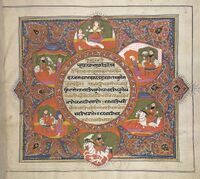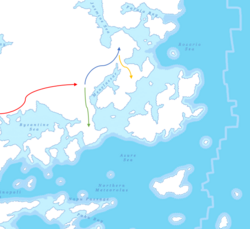History of Central Orient: Difference between revisions
No edit summary |
m (∆link) |
||
| (14 intermediate revisions by 2 users not shown) | |||
| Line 1: | Line 1: | ||
{{Region icon Eurth}} | |||
{{Template:Central Orient}} | {{Template:Central Orient}} | ||
The term | The term '''“Central Orient”''' defines itself as a region of the [[Orient]]al subcontinent containing countries such as [[Orioni]], [[Kotowari]], [[Tamurin]], [[Mekabiri]], [[Mahana]] and [[Namdatka]]. The region also goes by other names historically, such as the Kotowaran subcontinent<ref>”The term 'Kotowaran subcontinent' is often used by the west when describing the Central Oriental Region” (PDF) Retrieved 7th August 2022</ref> or the [[Menelassar Bay]] region<ref>”Menelassar Bay region as a term appeared during the 1700 and 1800s, when Tamur was at the forefront of Oriental powers. The term was often coined by [[Argis]]ian colonisers such as Delamaria” (PDF) retrieved 7th August 2022</ref>. The region's history is heavily intertwined with other countries outside the region, such as colonial powers from [[Argis]] and [[Aurelia]]. Central Orient has historically had powers in [[Tamurin]] and [[Kotowari]], which both had holdings over the rest of the region. | ||
==Timeline== | ==Timeline== | ||
===Prehistoric Orient (Before c.3300 BCE)=== | ===Prehistoric Orient (Before c.3300 BCE)=== | ||
====Paleolithic==== | ====Paleolithic==== | ||
[[File:Oriental Migration Map.png|thumb| | |||
Modern {{wp|humans}} began migrating to the central Oriental region from [[Amutia]] and [[Azania]] with the earliest appearing in modern-day [[Mahana]] and [[Namdatka]] around 70,000 years ago. Evidence suggests that some then migrated into [[Kotowari]] and [[Mekabiri]] at around 65,000 years ago, and finally from [[Mekabiri]] into [[Tamurin]] around 60,000 years ago. | [[File:Oriental Migration Map.png|thumb|250px|right|A map of the basic early Oriental migration .]] | ||
Reviews of archaeological evidence have suggested that occupation of the subcontinent by hominins was sporadic until approximately 700,000 years ago, and was geographically widespread by approximately 250,000 years before the present, from which point onward, archaeological evidence of proto-human presence is widely mentioned. Modern {{wp|humans}} began migrating to the central Oriental region from [[Amutia]] and [[Azania]] with the earliest appearing in modern-day [[Mahana]] and [[Namdatka]] around 70,000 years ago. Evidence suggests that some then migrated into [[Kotowari]] and [[Mekabiri]] at around 65,000 years ago, and finally from [[Mekabiri]] into [[Tamurin]] around 60,000 years ago. This dating is assumed by the discovery of a known presence of {{wp|Homo Erectus}} in Mahana and Namdatka. | |||
According to a historical demographer of Central Orient, Murugaverl Thajeev: | |||
<blockquote>Modern human beings—Homo sapiens—originated in Azania. Then, intermittently, sometime between 60,000 and 80,000 years ago, tiny groups of them began to enter the south-west of the Kotowaran subcontinent. It seems likely that initially, they came by way of the coast. … it is virtually certain that there were Homo sapiens in the subcontinent 55,000 years ago, even though the earliest fossils that have been found of them date to only about 30,000 years before the present.</blockquote> | |||
According to human historian specialist Claire Norris: | |||
<blockquote> Y-Chromosome and Mt-DNA data support the colonization of Central Orient by modern humans, originating in Azania. … Coalescence dates for most non-European populations average to between 73–55 ka. </blockquote> | |||
[[Orioni]]'s first evidence of humans derives from [[Marenesia]] rather than Azania like the rest of the [[Orient]], leading to the island being different to the rest of the subcontinent culturally and linguistically, with settlers arriving to the Orinese Isles as late as 8,000 BCE. | |||
====Neolithic==== | ====Neolithic==== | ||
Settled life appeared earliest with the [[Ghobari Valley]] around 9,000 years ago. This evolved slowly into the more developed [[Ghobari Valley Civilisation]] not long after in the 6th millennium BCE, modern day [[Mahana]]. In and around the same time, a fishing culture emerged in [[Mekabiri]]'s southern and eastern coasts, which also spread to [[Tamurin]]. | |||
=====Ghobari Valley Civilisation===== | =====Ghobari Valley Civilisation===== | ||
{{Main|Ghobari Valley Civilisation}} | {{Main|Ghobari Valley Civilisation}} | ||
Agriculture began to become centralised in the [[Ghobari Valley Civilisation]] by 5,500 BCE, according to evidence in the region. This was not only one of the region's first civilisations, but also one of the first for [[Eurth]]. The civilisation based itself around the historic [[Ghobari Valley]], which stretches through northernmost [[Mekabiri]] into [[Mahana]]. The Ghobari Valley Civilisation had a maximum extent stretching the entire river valley, up until the southernmost point of the [[Samripe Mountain Range]]. At the time the valley was fertile and humid, unlike it is today, due to the proximity to the last {{wp|ice age}}. | |||
===Bronze Age (c. 3300 – c. 1600 BCE)=== | ===Bronze Age (c. 3300 – c. 1600 BCE)=== | ||
===Iron Age (c. 1800 – 200 BCE)=== | ===Iron Age (c. 1800 – 200 BCE)=== | ||
===Amari period (Orioni)=== | |||
One of the first inhabitants of the Orioni Islands were the [[Amari people]]. Not native to the islands, they arrived from the east – likely from north-east Azania – and spread across the entire island. | |||
====Veyduan Period (c. 1800-1600 BCE)==== | ====Veyduan Period (c. 1800-1600 BCE)==== | ||
===Classical Period (c. 200 BCE – c. 650 CE)=== | ===Classical Period (c. 200 BCE – c. 650 CE)=== | ||
===Early medieval period (mid 6th c.–1200 CE)=== | ===Early medieval period (mid 6th c.–1200 CE)=== | ||
==References== | |||
{{reflist}} | |||
{{Eurth}} | {{Eurth}} | ||
Latest revision as of 12:09, 23 January 2024
| Part of a series on |
| Central Orient |
|---|
 |
The term “Central Orient” defines itself as a region of the Oriental subcontinent containing countries such as Orioni, Kotowari, Tamurin, Mekabiri, Mahana and Namdatka. The region also goes by other names historically, such as the Kotowaran subcontinent[1] or the Menelassar Bay region[2]. The region's history is heavily intertwined with other countries outside the region, such as colonial powers from Argis and Aurelia. Central Orient has historically had powers in Tamurin and Kotowari, which both had holdings over the rest of the region.
Timeline
Prehistoric Orient (Before c.3300 BCE)
Paleolithic
Reviews of archaeological evidence have suggested that occupation of the subcontinent by hominins was sporadic until approximately 700,000 years ago, and was geographically widespread by approximately 250,000 years before the present, from which point onward, archaeological evidence of proto-human presence is widely mentioned. Modern humans began migrating to the central Oriental region from Amutia and Azania with the earliest appearing in modern-day Mahana and Namdatka around 70,000 years ago. Evidence suggests that some then migrated into Kotowari and Mekabiri at around 65,000 years ago, and finally from Mekabiri into Tamurin around 60,000 years ago. This dating is assumed by the discovery of a known presence of Homo Erectus in Mahana and Namdatka.
According to a historical demographer of Central Orient, Murugaverl Thajeev:
Modern human beings—Homo sapiens—originated in Azania. Then, intermittently, sometime between 60,000 and 80,000 years ago, tiny groups of them began to enter the south-west of the Kotowaran subcontinent. It seems likely that initially, they came by way of the coast. … it is virtually certain that there were Homo sapiens in the subcontinent 55,000 years ago, even though the earliest fossils that have been found of them date to only about 30,000 years before the present.
According to human historian specialist Claire Norris:
Y-Chromosome and Mt-DNA data support the colonization of Central Orient by modern humans, originating in Azania. … Coalescence dates for most non-European populations average to between 73–55 ka.
Orioni's first evidence of humans derives from Marenesia rather than Azania like the rest of the Orient, leading to the island being different to the rest of the subcontinent culturally and linguistically, with settlers arriving to the Orinese Isles as late as 8,000 BCE.
Neolithic
Settled life appeared earliest with the Ghobari Valley around 9,000 years ago. This evolved slowly into the more developed Ghobari Valley Civilisation not long after in the 6th millennium BCE, modern day Mahana. In and around the same time, a fishing culture emerged in Mekabiri's southern and eastern coasts, which also spread to Tamurin.
Ghobari Valley Civilisation
Agriculture began to become centralised in the Ghobari Valley Civilisation by 5,500 BCE, according to evidence in the region. This was not only one of the region's first civilisations, but also one of the first for Eurth. The civilisation based itself around the historic Ghobari Valley, which stretches through northernmost Mekabiri into Mahana. The Ghobari Valley Civilisation had a maximum extent stretching the entire river valley, up until the southernmost point of the Samripe Mountain Range. At the time the valley was fertile and humid, unlike it is today, due to the proximity to the last ice age.
Bronze Age (c. 3300 – c. 1600 BCE)
Iron Age (c. 1800 – 200 BCE)
Amari period (Orioni)
One of the first inhabitants of the Orioni Islands were the Amari people. Not native to the islands, they arrived from the east – likely from north-east Azania – and spread across the entire island.
Veyduan Period (c. 1800-1600 BCE)
Classical Period (c. 200 BCE – c. 650 CE)
Early medieval period (mid 6th c.–1200 CE)
References
- ↑ ”The term 'Kotowaran subcontinent' is often used by the west when describing the Central Oriental Region” (PDF) Retrieved 7th August 2022
- ↑ ”Menelassar Bay region as a term appeared during the 1700 and 1800s, when Tamur was at the forefront of Oriental powers. The term was often coined by Argisian colonisers such as Delamaria” (PDF) retrieved 7th August 2022
